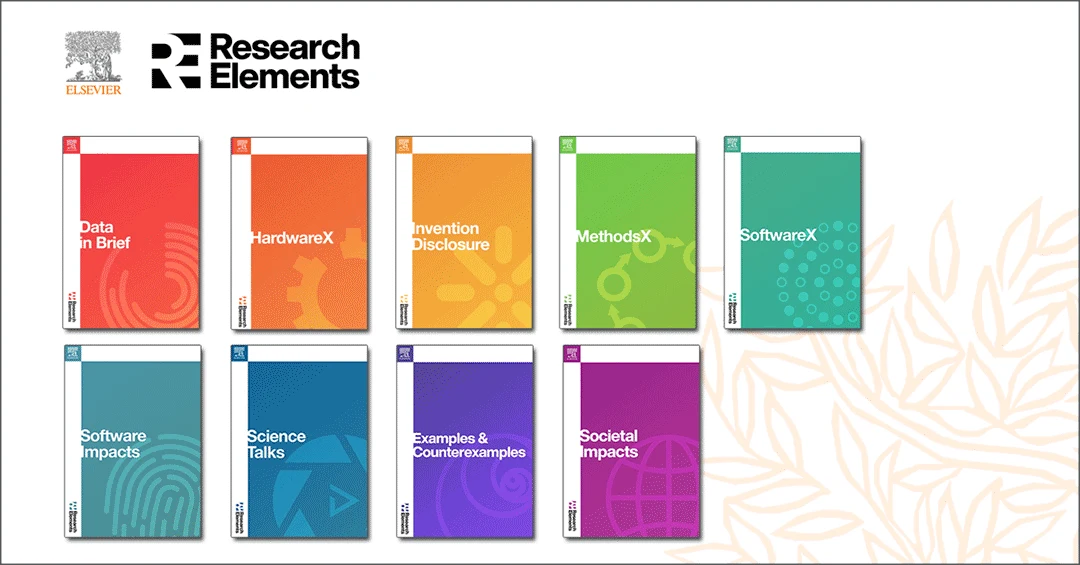Authors' Update - keeping journal authors in touch with industry developments, support and training

귀하의 브라우저가 완벽하게 지원되지 않습니다. 옵션이 있는 경우 최신 버전으로 업그레이드하거나 Mozilla Firefox, Microsoft Edge, Google Chrome 또는 Safari 14 이상을 사용하세요. 가능하지 않거나 지원이 필요한 경우 피드백을 보내주세요.
이 새로운 경험에 대한 귀하의 의견에 감사드립니다.의견을 말씀해 주세요 새 탭/창에서 열기
2023년 10월 18일
저자: Linda Willems

How often does the data or software generated during your research project end up stored on your computer, destined never to see the light of day? And what about the transcript of that speech you delivered at a recent conference?
For many researchers, once these “research objects” have served their purpose, they lie forgotten, filed away in an online directory. Yet, sharing them with other researchers brings a raft of benefits. These range from supporting open science and reproducibility to increasing your publication count.
Over the past few years, Elsevier has launched a suite of nine open access Research Elements journals. These titles publish peer-reviewed articles that describe the application of research objects such as data, hardware, methods, and inventions. Each article contains a link to the research paper associated with the object, as well as the location in which the object is stored; for example, an open online repository.
In the case of the journal Science Talks, 새 탭/창에서 열기 the editorial team is also experimenting with a new content delivery channel – video. Editorial team member Teresa Gagliano explains: “Experiments and findings are described on screen by the researchers who performed the experiments, removing one level of distance between readers and investigators.”

Teresa Gagliano
There have been ongoing concerns around the reproducibility of much research published. Openly sharing and describing the objects generated by your experiments is a great first step towards helping others replicate your work. Importantly, it can even help them build on it. And because the Research Elements journals are open access, your article is findable, accessible and reusable, supporting the goals of open science.
In addition, publishing an article on your research object can maximize the impact of your research; for example, by guiding readers to your original scholarly paper, helping them solve complex problems, and recording your contribution as a citable article. In fact, five of the Research Elements journals now have a CiteScore and an Impact Factor.
For authors who’ve published in Research Elements journals, another key benefit has been the ability to reach new readers, often outside of their usual network.
Lara M. Santos Ayllón, a PhD researcher at the University of Edinburgh in the UK, published a video in Science Talks 새 탭/창에서 열기 on the role of emerging technologies in the energy transition. “Sharing a video publication, open access, has likely increased my own network… it probably reached practitioners that are interested in this space but maybe wouldn’t have time to read a really long paper that I put out there,” she explains.

Lara M. Santos Ayllón
It’s a view shared by John Landers, a mechatronics engineer affiliated with Delft University of Technology in the Netherlands. He published a paper in Invention Disclosure on a new and unique prosthetic leg for above-knee amputees 새 탭/창에서 열기.
"It was the perfect platform for our publication. It allowed us to showcase our technology to the public while it was in the middle of the patenting process and provided exposure to an audience of entrepreneurs that could potentially become future partners.”
For John, another big draw was the fact that the journal publishes technology-focused articles. “The details of a new technology are often only available in patents or otherwise don’t get shared at all, which is a detriment to the scientific community.”

John Landers
One of the goals of open science is to make research more accessible to all. For postdoctoral researcher Rosa Celia Poquita-Du, who published a HardwareX article on EmerSense 새 탭/창에서 열기 – a low-cost alternative for in situ monitoring in aquatic systems – that’s where Research Elements journals can really shine. “Publishing in this journal allows us to reach a wider audience, especially research groups with limited budgets, who can leverage our design files and detailed instructions to replicate cost-effective instrumentation.”
She adds: “Additionally, it provides an excellent opportunity to showcase a lesser-known aspect of scientific research, namely, the ability to create things.”

Rosa Celia Poquita-Du
For Dr. Wendong Zhang, Assistant Professor and Extension Economist at Cornell University in the US, publishing data from a stock market analysis in Data in Brief 새 탭/창에서 열기 has transformed the way he thinks about this particular research object. “Before this submission, I typically stored and submitted the replication data and codes as an appendix or supplemental materials, which are generally ignored,” he explains.
“Publishing in this journal allowed me to think further about how to make the replication of my research easier for others. I have also been able to pass this knowledge on to my graduate students… a significant learning for them.”

Dr. Wendong Zhang
Clearly, there are many benefits to publishing non-traditional articles, so why not haul some of those old research objects out of the cupboard, dust them off and share them! The Research Elements journals can help you highlight contributions as diverse as societal impacts, software, and mathematical examples and counterexamples.
NB This article is partially sourced from interviews previously published on individual journal homepages on elsevier.com

LW
